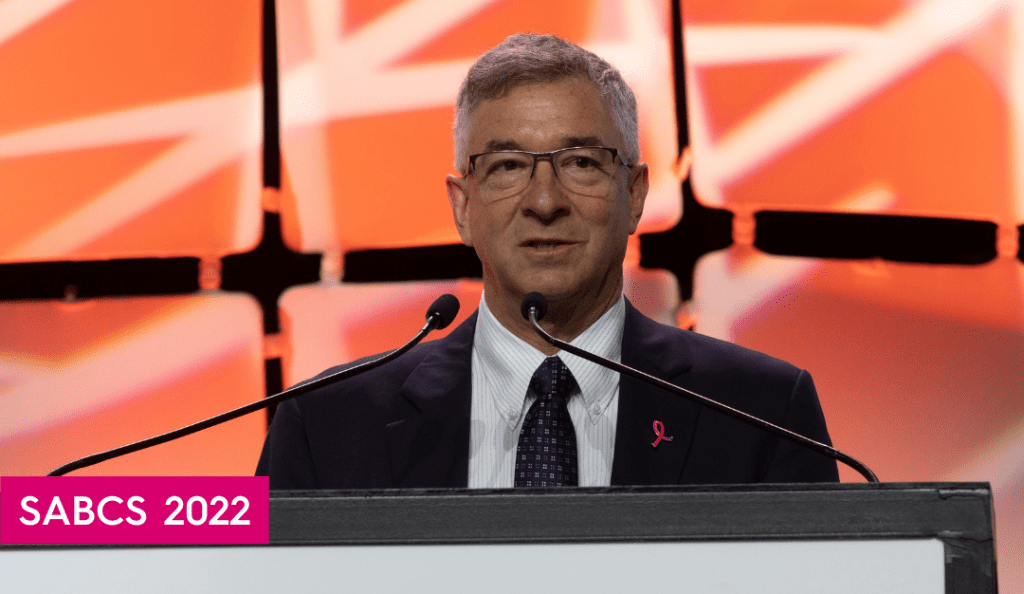Investigators discussed findings—and paths forward—for detecting and treating this newly-targetable breast cancer
Last month at the American Society of Clinical Oncology Annual Meeting, results from the DESTINY-Breast04 clinical trial heralded a new era in breast cancer research. In showing that low levels of the HER2 protein could be targeted with an antibody-drug conjugate (ADC) trastuzumab deruxtecan (T-DXd/Enhertu®), the study’s practice-changing results gave patients with metastatic breast cancer another treatment option and opened up a new avenue for further research. Ongoing DESTINY-Breast trials are further exploring T-DXd’s use; of note, DESTINY-Breast05 and 11 are the first trials of T-DXd in HER2-postive early-stage breast cancer.
In the months since the DESTINY-Breast04 clinical trial’s results were made public and T-DXd was granted accelerated approval by the FDA for use in the clinic, investigators have turned to several important questions: Are we accurately classifying HER2-low levels? Is HER2-low status consistent across a patient’s entire experience with breast cancer? And what is the lowest HER2 level where breast tumors will respond to ADCs like T-DXd?
At this year’s San Antonio Breast Cancer Symposium (SABCS), ADCs and HER2-low status were, unsurprisingly, prominent topics of discussion, and several researchers reported new developments that get us closer to answering these questions.
Refining how HER2-low is measured
BCRF investigator Dr. David Rimm discussed the limitations of current HER2-low detection methods noting that, in examining tumor samples, pathologists agree when HER2 is overexpressed 90 percent of the time. But, when they differentiate HER2-negative status from HER2-low, they only agree 60 percent of the time.
Since current tests are subjective, Rimm suggested that it is time to employ more digital and quantitative methods, and he introduced the automated quantitative analysis (AQUA®) tool developed in his lab. AQUA is significantly more sensitive when detecting cell surface markers and, in combination with other digital methods, will make it possible to quantitatively measure HER2 levels. With BCRF support, Dr. Rimm will continue to quantitatively refine estimates of HER2-low and understand the biology of this subset of breast tumor.
On behalf of his colleagues, Dr. Emmanuel Petricoin of George Mason University described a novel assay that was sensitive enough to detect HER2 in 40 percent of estrogen receptor–positive tumor samples previously identified as HER2-negative. Isolating pure cell populations from tissues (through a method called laser-capture microdissection) and quantifying proteins and protein modifications (a process known as reverse phase protein arrays) allowed his team to identify modest HER2 levels. Further studies will test this method more broadly.
Use of quantitative and more sensitive tests would allow standardization of HER2 levels between and across institutions and help to refine the lowest level of HER2 that is treatable with T-DXd. HER2 could then serve as a biomarker to predict which breast cancers will respond to current and future HER2-directed ADCs.
Does HER2-low status change?
Part of the HER2-low conversation at SABCS this year included discussions about whether or not its status changes as primary tumor cells become metastatic.
Presenting at the conference this year, researchers demonstrated that HER2-low status is dynamic through the course of patients’ breast cancer. In triple-negative breast cancers (TNBC), BCRF investigators Drs. Eric Winer, Nancy Lin, Nikhil Wagle, Elizabeth Mittendorf, and their colleagues examined HER2 expression in primary and matched metastases. They found that HER2 levels changed in approximately half of the TNBC cases, with the most frequent conversion from HER2-low to HER2-negative. This was observed in primary tumors compared to residual disease following neoadjuvant therapy as well as primary tumors compared to metastases.
Genomic and molecular analyses are underway to gain a better understanding of HER2 dynamics in TNBC and other subtypes of breast cancer.
HER2-low status and ADCs will undoubtably be huge topics of discussion at upcoming scientific conferences for a long time, and through research, we will further home in on the best detection methods and treatment strategies to improve outcomes and care.







